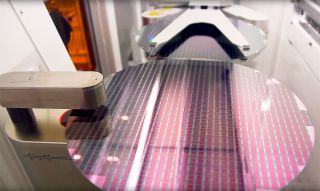Chinese company develops 65nm-capable lithography machine for domestic chipmaking — system still trails behind ASML and Nikon, though
But nobody knows the name of this company.

The Chinese government is promoting two new lithography machines to reduce reliance on foreign chipmaking tools amid U.S. sanctions, reports the South China Morning Post. Although these machines show notable technological improvements, they still trail industry leaders like ASML and Nikon.
The two machines are deep ultraviolet (DUV) lithography devices featuring argon fluoride lasers. One operates at a 193nm wavelength, offering a resolution below 65nm and an overlay accuracy under 8nm. The other operates at a 248nm wavelength, with a resolution of 110nm and an overlay accuracy of 25nm.
The best Chinese litho tool currently made in high volumes by Shanghai Microelectronics Equipment (SMEE) — the SSX600 — can produce chips on a 90nm process technology. Therefore, one of the new DUV tools is better than the SSX600, and the other is worse than the SSX600. However, they are significantly behind ASML's NXT:1980Fi and Nikon's NSR-S636E. ASML's least advanced DUV machine currently made has a resolution below 38nm and an overlay accuracy of just 1.3nm. Nikon's most advanced tool also has a resolution of 38nm and an overlay performance of 2.1nm.
| Header Cell - Column 0 | NXT:1980Fi | NSR-S636E | Litho Tool 1 | Litho Tool 2 |
|---|---|---|---|---|
| Light Source | ArF 193nm | ArF 193nm | ArF 193nm | ArF 248nm |
| Resolution | 38nm | 38nm | 65nm | 110nm |
| Projection Optics | 1.35 NA | 1.35 NA | ? | ? |
| Wafers per hour | 330 | 280 | ? | ? |
| Overlay Perfrormance | 1.3nm | 2.1nm | 8nm | 25nm |
The new systems represent a breakthrough in China’s domestic chip-making efforts, but the machines are not yet commercially available. The Ministry of Industry and Information Technology (MIIT) highlighted these advancements but did not disclose the companies responsible for the machines.
China has long sought to reduce its reliance on foreign suppliers, especially for critical semiconductor technology, but it still depends heavily on ASML’s machines. However, ASML has to get an export license from the Dutch government to sell its advanced DUV tools, which basically means that Chinese entities cannot get these machines.
SMEE, a state-owned company, is seen as China’s best chance to develop domestic lithography systems. However, SMEE lags significantly behind ASML and other global competitors. Last year, SMEE demonstrated a lithography tool capable of making chips using 28nm-class process technologies. However, the company still has to start mass production of this system.
Despite these challenges, SMEE has made strides. In March 2023, the company filed a patent for EUV lithography technology. This development shows some progress despite the hurdles presented by international sanctions and trade restrictions.
Stay On the Cutting Edge: Get the Tom's Hardware Newsletter
Get Tom's Hardware's best news and in-depth reviews, straight to your inbox.

Anton Shilov is a contributing writer at Tom’s Hardware. Over the past couple of decades, he has covered everything from CPUs and GPUs to supercomputers and from modern process technologies and latest fab tools to high-tech industry trends.
-
Amdlova Great we need Some Pentium D on market... first core 2 quad and somenthing more spiceeee... Will rock crysis era again!Reply -
das_stig I'm sure China will make great use of it, plenty of applications for older technology.Reply -
ivan_vy Reply
smart fridges don't need M4 to update the grocery list and buy the resupply on the amazon chinese equivalent.Amdlova said:Great we need Some Pentium D on market... first core 2 quad and somenthing more spiceeee... Will rock crysis era again!
They always think in the scale.
Most Popular





